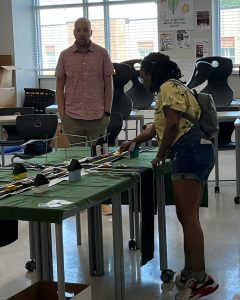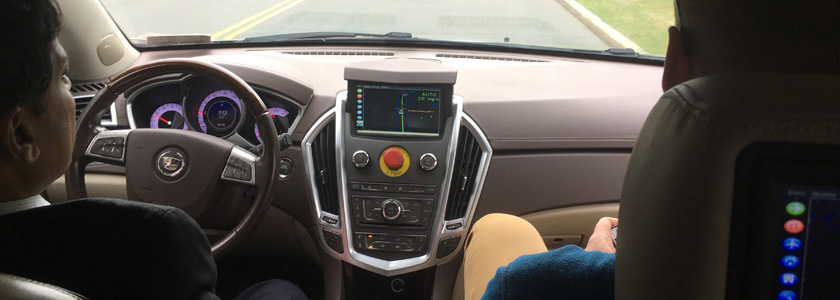CSCRS student researcher explores connections between transportation safety and structural racism
What is the relationship between structural racism and disparities in transportation safety outcomes? That question was the research focus of CSCRS graduate research assistant Nandi Taylor, a Ph.D. student in the UNC Gillings School of Global Public Health, Department of Epidemiology. Working with de Beaumont Foundation and UNC Highway Safety Research Center (HSRC) researchers, Taylor was the lead author on the journal article “Structural Racism and Pedestrian Safety: Measuring the Association Between Historical Redlining and Contemporary Pedestrian Fatalities Across the United States, 2010‒2019,” for the American Journal of Public Health. Her work was also highlighted in an April 2023 op-ed in The New York Times and a March 2023 Streetsblog USA post, and she presented on her work at the Society for Advancement of Violence and Injury Research conference in April 2023.
Taylor’s other work at HSRC includes analyzing linked North Carolina crash and trauma registry data for a project with a goal of characterizing the limitations of the KABCO Injury Classification Scale to accurately measure injury severity, as well as other projects related to the intersection of public health, health equity, and transportation safety.
Here’s Taylor in her own words:
Highlighting more CSCRS student accomplishments
CSCRS students have been busy and recognized for a variety of road safety projects:
- University of Tennessee, Knoxville (UTK) Ph.D. student A. Latif Patwary was named as a 2023 Lifesavers Traffic Safety Scholar. The civil and environmental engineering student has worked on the UTK CSCRS project Advancing crash investigation with connected and automated vehicle data – Phase 2, in addition to other CSCRS work. In a social media post he said, “By attending the [Lifesavers] conference, I learned more about the latest safety research, best practices and cutting-edge technologies being used to reduce motor vehicle crashes and fatalities. It also provided me with an excellent opportunity to network and collaborate with fellow safety scholars, safety professionals, and industry leaders.”
- Kristin Podsiad, a recent HSRC graduate research assistant and dual Master of Public Health and recent Master of City and Regional Planning graduate, worked on building micromodes.org, the first global surveillance system to collect data on fatal e-scooter injuries. This work was connected to the CSCRS project Understanding micromobility safety behavior and standardizing safety metrics for transportation system integration. Podsiad also delivered a CSCRS Research to Practice Bytes seminar introducing the resource in 2022.
- Evan Iacobucci, Ph.D., Postdoctoral Research Associate, UNC Department of City and Regional Planning (DCRP), co-authored the journal article “Examining injury trends in parcel delivery drivers in the United States: Challenges and opportunities” for the American Journal of Industrial Medicine; his co-authors included CSCRS researchers Noreen McDonald, DCRP, and Becky Naumann, UNC Injury Prevention Research Center (IPRC). Iacobucci also presented the CSCRS online seminar Reports from the battle for the curb: Using social media to understand safety challenges faced by urban delivery drivers.
- CSCRS students delivered additional online seminars:
- Meredith King, Graduate Research Assistant – Transportation Engineering, UTK, presented the March 2023 session What Can We Learn from Fatal Automated Vehicle Crashes? A Closer Look at Crash Narratives in Media.
- Four UNC graduate students presented the April 2023 session Developing an online Vision Zero resource library:
- Jordan April, Master of Public Health and Master of City and Regional Planning Student
- Lacie Emmerich, Health Behavior Master of Public Health Student
- Alessandro Figueroa, Health Equity, Social Justice, and Human Rights Master of Public Health Student
- Deborah Shoola, Health Behavior Master of Public Health Student
Student story retracted
CSCRS apologizes that a story in this edition showcasing the work of one of our students appears to have included mistakes. We are currently investigating the information contained in the article.
Honoring the life of CSCRS colleague David Ragland, a giant in the field of public health and traffic safety

David Ragland
We are deeply saddened by the news that our CSCRS research colleague and friend David Ragland, founder and Co-Director of the UCB Safe Transportation Research and Education Center (SafeTREC), died on May 7, 2023. Ragland, who was also professor emeritus of epidemiology at UCB’s School of Public Health, was a transportation injury research visionary, bringing together the public health and engineering perspectives long before a “systems” approach was popular. We are so fortunate to have been able to work with him as part of the CSCRS consortium, and know he will be missed by all of his colleagues and friends in the field.
Our friends at SafeTREC created this moving tribute page in his honor.
Focus on CSCRS education and professional development
CSCRS continues to provide and participate in a variety of learning activities including:
- The North Carolina Vision Zero Support Team (comprised of CSCRS researchers from IPRC, HSRC, and Gillings School of Global Public Health) will host the third annual NC Vision Zero Leadership Team Institute in June 2023, with support from CSCRS and the North Carolina Governor’s Highway Safety Program.

CSCRS researcher Wes Kumfer and a student at TigerFest
- HSRC researchers presented an interactive session at the 2023 Chapel Hill High School TigerFest event on May 24. The annual TigerFest is an alternative educational day where students can take classes on subjects that aren’t traditionally offered during the school year, and it provided the HSRC team a great opportunity to discuss road safety scenarios with high school students.
- IPRC hosted the May 2023 webinar “Re-framing Automated Speed Enforcement to Overcome Public Opposition” with speakers from Rutgers University. The webinar recording will be posted on IPRC’s YouTube channel.
- Several HSRC researchers presented during the March 2023 North Carolina Department of Transportation (NCDOT) Research and Innovation Summit. CSCRS-related presentations included:
- Advancing a Safe Systems Approach to Assessing the Traffic Impacts of Land Development
- Systemic Safety Analysis for Vision Zero: Lessons from Montgomery County
- CSCRS researchers engaged in about 50 activities at the 2023 Transportation Research Board (TRB) Annual Meeting in January 2023 including lectern presentations, poster presentations, workshops, and more. In addition, CSCRS held the fourth Safety Sunday @ TRB reception in conjunction with the conference.
- The Research to Practice Bytes series concluded with the last session on May 31, 2023. The series webpage contains session recordings, slide decks, and other materials related to the program.
Other CSCRS highlights
A quick rundown of additional recent CSCRS activities:
- Jill Cooper, UCB, received the 2023 NHTSA Public Service Award at the April 2023 Lifesavers National Conference.
- Several CSCRS researchers at UNC co-authored the following Vision Zero-related articles:
- The May 2023 article “Creating a Community-Level Document Library: Application Using Vision Zero Plans” for the Journal of Public Health Management & Practice.
- The May 2023 article “Mixed-methods approach to describing Vision Zero initiatives in United States’ municipalities” for Accident Analysis & Prevention.
- CSCRS researchers were interviewed by multiple media outlets. For example, CSCRS Director Laura Sandt was quoted in the article “Infrastructure needed for e-scooter safety” for UNC’s The Well.
CSCRS partner activities and resources
Here is an update on research-to-practice resources and activities from CSCRS partners:
- The National Cooperative Highway Research Program, in cooperation with HSRC, is inviting transportation, law enforcement, policymaking, and public health professionals to complete this ten-minute survey on applying Safe System practices in the U.S.
- NCDOT and North Carolina A&T State University are fielding a five-minute survey aiming to gauge public perceptions of railroad environments. The deadline to respond is June 30, 2023.
- The Insurance Institute for Highway Safety released a new online resource focusing on the role of speed in road safety efforts.
- The Vision Zero Network has released tips for communities applying for round two of the federal Safe Streets and Roads for All (SS4A) grant program.
Stay in touch
CSCRS is headquartered at HSRC. To stay up to date on HSRC’s work, including in the area of Safe System research, sign up for updates and announcements on the HSRC home page.
CSCRS Crossroads newsletters are archived here.






